MNP Group News Archive 2013-2015
Dr Dougan speaks at IoP conference
10 September 2015
 Dr Lorna Dougan from the Molecular & Nanoscale Physics group recently gave a talk at the Institute of Physics Conference at Manchester.
Dr Lorna Dougan from the Molecular & Nanoscale Physics group recently gave a talk at the Institute of Physics Conference at Manchester.
Dr Dougan's talk covered 'Single molecule studies of proteins from extremophile organisms', which is relevant to Dougan's current field of research.
The conference is taking place from 8-10 September and includes a host of speakers in Physical aspects of polymer science.
More information about the conference can be found here.
Complex Fluids Under Extreme Conditions
30 July 2015
Registration open!
Complex Fluids Under Extreme Conditions
15th September 2015
University of Durham, Durham, UK
http://compfuec.iopconfs.org/home
This one day meeting will gather researchers from the wide complex fluids community (polymers, colloids, lipids, interfaces) who have an interest in extreme conditions, such as pressure, temperature, confinement, and external fields. The meeting will include time for an extended poster session, providing the opportunity for discussion and exchange of ideas in this exciting research area.
Invited Speakers
Professor Roland Winter, University of Dortmund, Germany
Title: Effects of Temperature, Pressure, Crowding and Osmolytes on the Interaction Potential and Phase Behavior of Concentrated Protein Solutions
Professor Glen McHale, University of Northumbria, UK
Title: Structured, Shaped and Slippery Interfaces
Dr Valeria Garbin, Imperial College London, UK
Title: Extreme deformation of complex fluid interfaces
Dr Hugo Christenson, University of Leeds, UK
Title: Freezing of Liquids in Confinement
The meeting is organised by the Institute of Physics Liquids and Complex Fluids Group. For more information, please contact Dr Lorna Dougan (L.Dougan@Leeds.ac.uk) and Dr Margarita Staykova (Margarita.Staykova@durham.ac.uk)
Summer School kicks off
23 July 2015
The School of Physics and Astronomy hosted a 4 day Ogden Trust Physics Summer School this week, with 30 AS-level physics students from across the wide Yorkshire area attending. The event was aimed at high achieving students, and included a mix of workshops and lectures designed to challenge and improve their mathematical skills.
Students also had the opportunity to join research groups in the School for a day, visiting research laboratories and gaining experience of using state-of-the-art equipment. This included spectrometers, x-ray diffractometers, liquid crystals and single molecule force spectroscopy.
Soapbox Science!
22 June 2015
On 20th June Dr Lorna Dougan joined 11 other scientists to take part in ‘Soapbox Science’ in Belfast. Soapbox Science is a novel public outreach platform for promoting women scientists and the science they do. These events transform public areas into an arena for public learning and scientific debate; following the format of London Hyde Park’s Speaker’s Corner, which is historically an arena for public debate. With Soapbox Science, everyone has the opportunity to enjoy, learn from, heckle, question, probe, interact with and be inspired by leading scientists.
At the event, which attracted ~2000 people, Lorna presented her research on ‘Using physics to explore life in extreme environments’. This included an introduction to the world of extremophiles, single molecule force spectroscopy and demonstrations of polymer collapse and protein folding. To find out more about Soapbox Science please visit: http://soapboxscience.org/
Dr Lorna Dougan would like to thank the Science & Technology Facilities Council (STFC) who sponsored her attendance at Soapbox Science, as well as the European Research Council (ERC) who fund her research on ‘Extreme Biophysics’
Critchley to discuss Theranostics
27 April 2015
Dr Kevin Critchley from the MNP group in the School of Physics and Astronomy will be speaking at the 'Nanotechnologies in Drug Delivery Congress' this week in Heathrow, UK.
Dr Critchley will be discussing 'Thernostics: Combining Diagnostics and Delivery in a Single Device', as part of a number of talks on Nanotechnologies from a range of global speakers in the field.
The conference is supported by the British Society for Nanomedicine, French Society for Nanomedicine and Nano Med North and will be running from 27th to 28th April 2015.
Seminar cancellation
13 March 2015
We regret to inform you that the MNP seminar on 25th March has been cancelled, we hope to have Dr. Teuta Pilizota from the University of Edinburgh visit us in the near future.
She's done it again!
11 March 2015
Once again we would like to say congratulations to Dr Lorna Dougan who is an Associate Professor in the School of Physics and Astronomy.
Lorna was recently recognised for her efforts in Polymer Science and received an award celebrating Women in Science. Lorna has since been honoured with the Suffrage Science Award along with two others from the University of Leeds.
The awards are selected by current MRC Suffrage award holders to distinguish outstanding researchers in science and engineering.
For further information, please click here.
Celebrating Women of Achievement 2015
5 March 2015
Congratulations to Dr Lorna Dougan who has been recognised for her achievements and contributions to polymer science. Lorna recently accepted the Macro Group UK Young Researcher Medal from the Royal Society of Chemistry.
Lorna is part of a select group that has been recognised by the University of Leeds as 'Women of Achievement 2015', and has been listed on the website.
For more information on Lorna's work, please visit the MNP webpage and Lorna's own group webpage.
Once again, congratulations to Lorna.
UK - India collaborations
23 February 2015
The UK-India Research Seminar, hosted by the University of Leeds was held last week at Weetwood Hall. The seminar was a great success and has opened doors for new collaborations across a wide range of UK and Indian Institutions.
Dr Kevin Critchley organised the 2.5 day seminar and pulled together a range of speakers from across the UK in addition to the 5 delegates from India to discuss ‘Photo-responsive Functional Surfaces for Bio-Nano Applications in Healthcare’, with speakers including Leggett, Bushby, Singh, Evans, Turner, Mendes, Summers and Hariharan. The meeting identified a number of ideas that will serve as the basis for collaboration between researchers in the UK and India.
Funding for the seminar came from the Department for Business, Innovation and Skills (BIS) through the Royal Society and by the Department for Science and Technology (DST) India.
For more information on the seminar and final delegate list please visit the website.
Three pronged attack on cancer cells
17 February 2015
Researchers including Dr Sunjie Ye and Professor Steve Evans from the School of Physics and Astronomy have shown that gold nanotubes have many applications in fighting cancer including: internal nanoprobes for high-resolution imaging; drug delivery vehicles; and agents for destroying cancer cells
High recurrence rates of tumours after surgical removal remain a formidable challenge in cancer therapy. Chemo- or radiotherapy is often given following surgery to prevent this, but these treatments cause serious side effects. Gold nanotubes – that is, gold nanoparticles with tubular structures that resemble tiny drinking straws – have the potential to enhance the efficacy of these conventional treatments by integrating diagnosis and therapy in one single system.
A new technique to control the length of nanotubes underpins the research. By controlling the length, the researchers were able to produce gold nanotubes with the right dimensions to absorb a type of light called ‘near infrared’, which passes through human tissue. Therefore gold nanotubes travelling through the body will absorb light of the right frequency and convert it to heat, rather like the warmth generated by the Sun on skin. Using a pulsed laser beam, it was possible to rapidly raise the temperature in the vicinity of the nanotubes so that it was high enough to destroy cancer cells.
A new type of imaging technique called ‘multispectral optoacoustic tomography’ (MSOT) was used to detect gold nanotubes which had been intravenously injected in mice. It was also shown that gold nanotubes were excreted from the body and therefore unlikely to cause problems in terms of toxicity, an important consideration when developing nanoparticles for clinical use.
The nanotubes can be tumour-targeted and have a central ‘hollow’ core that can be loaded with a therapeutic payload. This combination of targeting and localised release of a therapeutic agent could, in this age of personalised medicine, be used to identify and treat cancer with minimal toxicity to patients.
The use of gold nanotubes in imaging and other biomedical applications is currently progressing through trial stages towards early clinical studies.
The study details the first successful demonstration of the biomedical use of gold nanotubes, in a mouse model of human cancer. The research paper, ‘Engineering Gold Nanotubes with Controlled Length and Near-Infrared Absorption for Theranostic Applications’, was published in the journal Advanced Functional Materials on 13 February 2015.
The image shows pulsed, near infrared light (shown in red), shining onto a tumour (shown in white) that is encased in blood vessels. The tumour is imaged by multispectral optoacoustic tomography via the ultrasound emission (shown in blue) from the gold nanotubes. Image credit: Jing Claussen (iThera Medical, Germany)
Dougan to speak in Baltimore
9 February 2015
Dr Dougan has been invited to speak at an upcoming symposium in Baltimore, USA.
The Symposium is on 'Extremophiles: Testing the Physics Limits of Living Systems', and will be held at the American Biophysical Society.
Dr Dougan will be discussing her own area of research, which is extremely relevant to the topic. Dougan's talk will be on 'Using single molecule force spectroscopy to probe proteins from extremophile organisms.'
Other speakers include:
- Georges Feller, University of Liege, Belguim
- Catherine Royer, Rensselaer Polytechnic Institute, Chair
- Douglas Bartlett, University of California, San Diego
Barbara Hepworth Lecture
4 February 2015
Dr Lorna Dougan has been invited to give a lecture as part of the Barbara Hepworth Lecture series at Wakefield Girls High School.
The Barbara Hepworth Lectures, named after a former pupil of the School, take place on Wednesday afternoons. Speakers in the past have included Baroness Prashar, writer and comedian Natalie Haynes, entrepreneur Emily Cummins, and many other noted experts in diverse fields, from academia, business, and the arts. The purpose of the lecture series is to provide an education outside and beyond the curriculum and to give the girls an insight into the developing and future world that they will help shape. Wakefield Girls High School encourages the girls to develop an intellectual curiosity about everything and to challenge conventional thinking.
As part of Dr Dougan’s talk, she will be discussing how physics can be used to understand life in extreme environments, as well as providing an insight into the rewards of a career in science.
Prof Evans to give School Colloquium
27 January 2015
Professor Evans, Head of the Molecular and Nanoscale Physics group with be giving a School Colloquium at the University of Nottingham on Wednesday 28th January. Prof. Evans is the School of Physics and Astronomy’s guest speaker and will be discussing, “Resonance: The development of optical and acoustic systems for imaging and therapy".
For further information of the University of Nottingham and their Physics department, please click here.
For further information of Professor Evans' current research, please click here.
Stoner Colloquium
22 January 2015
The School of Physics and Astronomy will be hosting the next Stoner Colloquium on 10th March 2015. The School is delighted to announce that Professor Roy Sambles from University of Exeter and President Elect of the Institute of Physics (IOP) as the guest speaker.
The Stoner Colloquium is a prestigious Colloquia series, which is held in honour of Professor E.C.Stoner, who was a Professor in the department from 1939 to 1963. Stoner also held the Cavendish Chair from 1951 to 1963 and the building that houses the department is named after him.
Professor Sambles will be discussing ‘Electromagnetic metasurfaces – from butterflies to battleships’ in the Roger Stevens Lecture Theatre from 5pm on Tuesday 10th March. If you are interested in attending, please contact Josie Bramhall (J.E.Bramhall@leeds.ac.uk).
Category 2 Winner
17 December 2014
Congratulations to Radwa Abou-Saleh who won Category 2 of the Photo competition. The aim of category 2 was to submit photos which relating to the group in a funny or interesting way.
Radwa submitted a wonderful picture of her daughter with a Macro-Bubble, which was greatly received by the judges. Thank you to Dr Laurence Wilson from the University of York who helped judge the photos for us.
Photo competition winner!
12 December 2014
Congratulations to Andrew Harvie, Victoria Mico and Adam Churchman for their winning submission to the MNP photo competition. The three of them won category one for scientific images that represent the group. They created the groups name from PDMS, illuminated by the fluorescence of various sizes and colours of CdSe quantum dots.
Radwa Abou-Saleh won category two with a picture of her daughter and a macro-bubble. The second category was an opportunity for members of the group to send photos that relate to the group away from the lab.
Thank you to all of you who submitted, we had a great time looking through each of your photos and they will all feature on the website and elsewhere in relation to the group's work shortly.
Origami Santa
11 December 2014
Santa has taken a new form this year thanks to Dr Sunjie Ye of the Molecular and Nanoscale Physics group. Sunjie has pulled together the different elements of the groups research to create a Scientific take on Santa.
1) Eyes: Q and D to represent Quantum Dots.
2) Mouth: Lipid bilayer.
3) Box repents the magic HORIZON bubble box.
4) The ribbon ball on the box represents micro bubbles.
5) The origami helix is a DNA.
6) The hexagonal decoration on the santa hat is from a colour TEM image of a gold nano plate.
The Origami Santa is proudly displayed in the MNP meeting area so please do take a look.
MNP Outreach Day
8 December 2014
On Wednesday 10th December members of the Molecular and Nanoscale Physics group will be working on outreach projects.
All will be unveiled on Wednesday followed by the announcement of the MNP Photo Competition, which has been running for the past couple of months.
Congratulations Dr Booth
27 November 2014
Yesterday the MNP group celebrated Matthew Booth becoming a Dr after successfully passing his PhD viva.
Matthew Booth joined the MNP group under the supervision of Dr Critchley in September 2010. He had just graduated from his Taught Masters degree in Quantum Information at Leeds and he was looking for a new challenge.
His PhD research project was to study copper indium sulphide quantum dots for potential applications for biomedical imaging. These quantum dots are thought to be a good alternative to the toxic heavy metal CdSe nanoparticle most commonly used. The electronic band structure of CuInS2 quantum dots was found to be much more complicated than first thought. The research community had proposed various models for the electronic structure; however, Matthew set himself the task of settling the matter. He used ultrafast laser experiments to analyse the nanoparticles and this became a major part of his thesis.
During his PhD he authored three articles that were published in international science journals and won a poster prize at a conference. Matthew is currently writing up another article and applying for postdoctoral research positions.
Medal awarded for research
25 November 2014
Dr Lorna Dougan received a medal award for the 2013 Macro Group Young Researchers Medal for her work and contribution to polymer science in single molecule force spectroscopy.
As part of the award, Dr Dougan will be presented with a bronze medal and has been invited to give an award lecture at the Royal Society of Chemistry, London. The lecture will take place on 16th December and Dr Dougan will present her work from her recent developments in ‘Single molecule force spectroscopy as a tool to probe the dynamics of proteins from extremophile organisms.’
Once again, we would like to give our congratulations to Dr Dougan on receiving this award. If you would like find out more about Dr Dougan’s work or Macro UK please click on the links.
Photo competition
24 November 2014
The closing date for the MNP Photo Competition is drawing close.
There are two categories that you can submit to:
I. Scientific Images
II. Funny, interesting, pictures group members, MNP trips etc.
So if you think you've got a great photo that fits into either of these then send these through to J.E.Bramhall@leeds.ac.uk by 30th November. All entries will be used to create a collage to represent the group and the winning submission will receive a free Christmas meal with the group.
Best of luck!
New Biomedical Facility on the Horizon
18 November 2014
Congratulations to Professor Steve Evans and Drs Kevin Critchley and Jung-uk Shim from the MNP group in Physics and Astronomy, University of Leeds, who has been awarded a joint MRC grant for Single Cell Genomics with members of the Leeds Teaching Hospitals NHS Trust.
A joint facility that will permit new biomedical research approaches, based on sequential isolation, manipulation, observation and eventual destructive analysis (or culture and expansion) of single cells will be generated from the funds.
The facility will focus on delivering biological insights and capabilities that are relevant to their clinical areas of expertise and excellence.
Q-Dot Paper
17 November 2014
Dr Kevin Critchley has recently had a paper published in the 'The Journal of Physical Chemistry' on the subject of Q-Dots.
The paper is titled, 'Sub-Bandgap Emission and Intraband Defect-Related Excited-State Dynamics in Colloidal CuInS2/ZnS Quantum Dots Revealed by Femtosecond Pump–Dump–Probe Spectroscopy', and has contributions from Kraatz, Booth, Whitake and Nix.
To read the paper, please click here.
Congratulations to Dr Heath!
13 November 2014
Congratulations to George Heath who successfully passed his PhD viva on 12th Nov 2014.
George’s work involved studying model lipid membrane systems mainly using the technique of atomic force microscopy. His work encompassed applications in nano-patterning of lipid bilayers, study of the critical point behaviour of model membranes, protein partitioning and diffusion in lipid membranes, polymerisation of actin on cationic lipids at sub-critical concentrations and coating theranostic microbubbles with actin layers.
His project supervisors were Dr. Simon Connell and Prof. Stephen Evans. The internal examiner was Dr. Neil Thomson and the external examiner Prof. Erik Reimhult of the Universitat for Bodenkultur, Vienna.
Life in Extreme Environments
12 November 2014
The Physics of Life Network and School of Physics and Astronomy hosted a two-day focused workshop on Life in Extreme Environments at Weetwood Hall yesterday.
The day included a variety of Flash Presentations, networking opportunities and a key note speech from Professor Joseph Zaccai from the Institut Laue Langevin, Grenoble. Professor Zaccai’s talk discussed ‘Dynamics and adaptation to extreme environments’ and was a great addition to the workshop.
Dr Lorna Dougan, Associate Professor in the Molecular and Nanoscale research group in the School chaired the event with assistance from Professor Steve Evans. The aim of the workshop was to highlight areas of research in the remit of Extremophiles and consider how physicists, Biologists and others could form collaborations to develop existing research.
For further information about the event, speakers and network, please click here.
Upcoming Winter School
3 November 2014
The Leeds EPSRC Nanoscience and Nanotechnology Facility (LENNF), Winter School is free and open to all PhD students in relevant fields at UK Universities.
It will include lectures, demonstrations and Q&A sessions about the equipment and techniques available through the facility. The School will run from 13-15th January, and accommodation will be provided and travel costs reimbursed by LENNF.
Registration closes on 24/11/2014 please contact Dr Kellye Curtis (K.S.Curtis@leeds.ac.uk) for further details and to register.
Please visit the website: http://www.engineering.leeds.ac.uk/lennf/
Last chance to book onto workshop!
29 October 2014
Understanding the Physics of Life in Extreme Environments
From Molecules to Systems – Focussed Workshop 3 Open for Registration
Confirmed speakers and their talk titles:
Prof Joseph Zaccai, Institut Laue Langevin, Grenoble
‘Dynamics and adaptation to extreme environments’
Prof Michael Danson, Centre for Extremophile Research, University of Bath
‘Extremophiles and their enzymes: finding the balance between structural rigidity and catalytic flexibility’
Prof Jennifer Littlechild, Biosciences, University of Exeter
‘Thermophilic Enzymes for Biocatalysis’
Dr Thorsten Allers, School of Life Sciences, University of Nottingham
‘Life without DNA replication origins How to improve on nature’
Dr Nick Brooks, Department of Chemistry, Imperial College London
‘Probing membrane structure and dynamics at high pressure’
Following our Plenary Events, we are organising a series of Focussed Workshops. The main purpose of these meetings will be to provide opportunities for researchers to talk and interact through, for example, brief flash presentations, speed-dating exercises, facilitated discussions and other activities. Each meeting also features a top-class line-up of invited speakers to set the scene and stimulate discussion.
Here we will focus on the specific challenges at the physical/life sciences interface relating to life in extreme environments. These concern questions spanning molecular to cellular scales and include but are not limited to: uncovering the biophysical origins of molecular evolution, the effects of high pressure, high/low temperature and salt on the structure, dynamics and mechanics of biological systems, the current and potential applications of enzymes from extremophilic organisms in industrial biotechnology and biocatalysis, and DNA replication, recombination and repair under extreme environmental conditions. The meeting will include a series of short talks from leading biologists and biophysicists to “set the scene” for intensive discussion into developing novel and exciting lines of interfacial research in this area.
Our goal is to provide a context in which researchers can build new collaborative cross-disciplinary partnerships to address key challenges in Understanding the Physics of Life.
Life in Extreme Environments, Weetwood Hall, Leeds, November 10/11
http://www.physicsoflife.org.uk/events/life-in-extreme-environments/
Cost only £95 including all meals and accommodation
To register visit:
http://onlineshop.shef.ac.uk/browse/extra_info.asp?compid=1&modid=2&deptid=6&catid=4&prodid=325
From Molecules to Systems
Towards an Integrated Heuristic for Understanding the Physics of Life
An EPSRC Grand Challenge Network Plus
Network Chair: Professor Graham Leggett
Department of Chemistry
The University of Sheffield
Brook Hill
Sheffield S3 7HF
Scientific Seminar to go ahead in 2015
21 October 2014
Congratulations to Dr Kevin Critchley of the MNP group in Physics and Astronomy, who has recently been awarded a small grant from the ‘India-UK Scientific Seminar Scheme’, to fund a 3 day meeting to develop new ideas in the theme of 'Photo-responsive Functional Surfaces for Bio-Nano Applications.’
The Scheme is funded by The Royal Society and the DST (India) and is for mid-career scientists wishing to organised a small 3-day scientific seminar between groups of scientists from India and the UK. The meeting will run with the intention to promote collaboration and knowledge transfer whilst encouraging participation and interaction across the wider research community.
The Possibilities are endless
10 October 2014
New study demonstrates how stable ‘lipid membranes’ – the thin ‘skin’ that surrounds all biological cells – can be applied to synthetic surfaces.
Professor Steve Evans and George Heath (PhD student) from the Molecular and Nanoscale Physics Group, in the School of Physics and Astronomy, at the University of Leeds have taken a crucial step forward in bio-nanotechnology, a field that uses biology to develop new tools for science, technology and medicine. Their study published today in the journal Nano Letters explains how their new technique can use these lipid membranes to ‘draw’ – akin to using them like a biological ink – with a resolution of 6 nanometres (6 billionths of a meter), which is much smaller than scientists had previously thought was possible.
“This is smaller than the active elements of the most advanced silicon chips and promises the ability to position functional biological molecules – such as those involved in taste, smell, and other sensory roles – with high precision, to create novel hybrid bio-electronic devices,” said Professor Steve Evans, from the School of Physics and Astronomy at the University of Leeds and a co-author of the paper.
See the full press release here
The full study which features in Nano Letters can be viewed here
MNP Photo Competition!
2 October 2014
We have launched a MNP Photo Competition for all you budding photographers out there!
Everyone in the group is welcome to participate and the winner will go free to the MNP Christmas meal this year and have their photos featured in school brochures and the website!
Rules:
There are 2 categories that you can enter
I. Scientific Images
II. Funny, interesting, pictures group members, MNP trips etc.
You are welcome to enter both or just one of the categories, there will be a winner from each announced.
Deadline - 30th November
Please submit entries to: J.E.Bramhall@leeds.ac.uk
All submitted entries will help form a collage, which will be displayed in the MNP area of the School.
Good luck and get snapping!
Natasha Rhys serves as Associate Chair
30 September 2014
Natasha Rhys of the MNP group has served as Associate Chair of the 2014 Gordon Research Seminar on Water & Aqueous Solutions. This meeting ran on the 26th-27th July, at Holderness School, New Hampshire, USA.
The Gordon Research Seminars (GRS), as well as the 5-day Gordon Research Conferences (GRC) that follow them, are biennial events that bring together international researchers to discuss new, unpublished science on a specific topic. Whilst a GRC brings in researchers of all career levels, a GRS is focused solely on PhD students and postdocs, allowing them to network and present their research, preparing them for the GRC that runs straight after.
As Associate Chair, Natasha helped to organise and host the meeting along with the GRS Chair, Dr Matthias Heyden (Max Planck Institute for Coal Research, Germany). 63 participants from across the world attended the meeting, with a range of topics in the field of water research covered. The programme featured 10 contributed talks and 2 poster sessions, allowing for discussions to be generated throughout the meeting, as well as a session focusing on career development and becoming an independent researcher.
Natasha was awarded a Royal Society of Chemistry (RSC) Travel Grant and an Institute of Physics C R Barber Trust Grant help support her attending both the GRS and GRC. She also was awarded an RSC ‘Small Grant for Scientific Activities’, which was used to help waiver the registration costs for many of the GRS participants.
The school and group would like to congratulate Natasha on this fantastic achievement.
More information about GRS’s can be found here: https://www.grc.org/grs.aspx
Physics of Life Network conference
25 September 2014
Dr Lorna Dougan will be hosting the next Physics of Life Network event which is being held at Weetwood Hall in Leeds. The event will be in the form of a workshop on the topic of 'Life in Extreme Environments'.
The workshop takes place on 10th to 11th November and will include a series of invited talks from experts in the field as well flash presentations and discussion involving all participants. The event is open to all academics and research fellows with an active interest in the area.
For more information and details about how to register, please click here.
2014/15 seminar series kicks off
24 September 2014
On Wednesday 8th October the MNP seminar series for 2014/15 kicks off with Dr Martin Fischlechner joining the group for a talk on 'Biology for Materials - Materials for Biology....combining materials with genetically encoded functions'.
The seminar will take place 2-3pm in the Roger Steven's Lecture Theatre 16 and everyone is welcome to attend!
MNP Speakers at Bio Conference
10 September 2014
Three members of academic staff from the School of Physics and Astronomy have been invited to speak at the ‘Single Biomolecules – in silico, in vitro & in vivo’ at the University of Hertfordshire. The conference runs from 11-13th September.
Drs’ Lorna Dougan, Jung-uk Shim and Sarah Harris of the MNP and SMP groups will be individually discussing difference elements of single biomolecules.
For more information about the conference and further details about the scientific programme, please click here
8 September 2014
Bhaskara Pinniniti has been visiting the School of Physics and Astronomy for the past two months to continue his research on the development of new photo removable protecting groups for making photo patterned surfaces.
As part of the latest MNP Away Day, the group took a trip to Whitby and Robin Hoods Bay to show Bhaskara the East Coast and sample some of England's finest fish and chips. Bhaskara is due to return to India later this week.
We wish Bhaskara the best of luck with his studies at the Indian Institute of Technology in Kharagpur.
To see the photos, please click here.
Paper published
4 September 2014
A paper on 'Stable single alpha helices are constant force springs in proteins' has recently been published in the Journal for Biological Chemistry.
Dr Lorna Dougan, Associate Professor in Molecular and Nanoscale Physics at Leeds, has contributed elements of her research to the paper, along with colleagues from Molecular and Cellular Biology.
To view the paper, please click here.
Grant Success
28 August 2014
Congratulations to Dr Hugo Christenson of the Molecular and Nanoscale Physics group, who has been awarded a £1m EPSRC Grant, titled ' Control of Crystal Nucleation on Surfaces'.
The grant will be a study of nucleation crystals on surfaces in vapour, solutions and pure liquids, including water. The grant will cover 3 years of research and will allow funding for 2 PDRAs, one of which will be based in the School of Physics and Astronomy.
Dr Gavin Burnell (PHAS), Dr Ben Murray (Earth and Environment) and Professor Fiona Meldrum (Chemistry) are all Co-Investigators on the grant and will be working closely with Dr Christenson.
Pop-up Lab comes to Leeds
27 August 2014
Members of the Molecular and Nanoscale Physics group in the School have been participating in BioLeeds and the ASMbly 2014 (Artists. Scientists. Makers.) pop-up Lab in Leeds.
The pop-up lab is a series of different projects open to anyone with an interest in Science and Art. There are a number of different experiments, models etc. to get involved with, and on Friday afternoon last week, our own physicists decided to do just that.
Johanna Galloway, George Heath and Katherine Kendrick constructed their own balloon model of a Buckeyball, which is a spherical molecule made up of twenty hexagons, twelve pentagons and 60 carbon atoms. This was a test run to find out how to construct bioinspired natural structures with modelling balloons, which people will be able to build and add to in the pop-up lab.
For further details you can read the blog by clicking here or by contacting Jo Galloway J.M.Galloway@leeds.ac.uk
Keynote Speech at the Spanish National SPM Meeting
21 August 2014
Dr Neil Thomson is giving a Keynote Talk at the Spanish National SPM Meeting, Fuerza Y Tunel 2014 (FyT 2014), in San Sebastian 27th to 29th August 2014.
The title of his talk is “Realising quantitative dynamic atomic force microscopy to probe transactions of DNA at the single molecule level”.
This is the 9th edition of a series of conferences that began in Barcelona in 1998 and brings together scientists who share an interest in the applications, the use, the development and the theoretical description of technology based on scanning probe microscopes (SPM). The program has dedicated sessions to atomic force microscopy, scanning tunneling microscopy and theory of local probes techniques covering a wide range of applications from soft matter physics and biophysics to surface science in vacuum. There will be three invited lectures of experts on AFM and STM, as well as more than thirty selected short talks. The meeting also honours the retirement of Prof. Arturo M. Baró and showcases his extensive and inspiring career pioneering scanning probe techniques in Spain.
For more information see:
http://dipc.ehu.es/ws_programa_abstracts.php?id=95#
George Heath speaks at SPM 2014
19 August 2014
George Heath, a Postgraduate in the MNP group in Physics & Astronomy, has been invited to give a talk in Toronto, Canada.
George will be attending the 'International Conference on Scanning Probe Microscopy on Soft and Polymeric Materials', where he will be discussing 'Fast Scan Atomic Force Microscopy of Supported Lipid Bilayers: From Formation Techniques to Lipid Rafts'.
The conference runs from 2nd - 6th September and will cover a full range of scanning probe microscopy on soft matter, polymeric materials, as well as biological systems. Further information can be found here.
Another Successful Microbubble Symposium comes to a close
16 July 2014
The fourth annual Microbubble Symposium came to a close yesterday afternoon, with Sir Alex Markham giving the closing remarks.
The Symposium included speakers from across the globe discussing the Fabrication, Characterisation and Translational Applications of Microbubbles. Speakers included Lee, Thomson, Willmann and Klibanov amongst others.
The Symposium saw a number of sponsors in attendance, showcasing their work and equipment. iZon, Malvern Instruments and Specialised Imaging all had stands at this year's Symposium, which alloowed delegates to take a look at what they could offer.
The Symposium also included a wine tasting session on the Monday evening. The session was lead by Tate Smith's Wine Account Manager, Scott Hanby (WSET), he provided a selection of reds and whites from across the globe and he finished the session off with an English Sparkling, Nyetimber.
Thank you to everyone who attended and took part in this year's Microbubble Symposium.
Professor Evans to speak at ICOMF tomorrow
8 July 2014
Professor Stephen Evans, Head of the Molecular and Nanoscale Physics group, will be presenting a talk at this year's International Conference on Organized Molecular Films (ICOMF 2014) in Jeju, South Korea. The conference is in it's 15th year and it's international reknown.
The conference will cover a large range of topics, including, Self-assembly and Nanoscale Organisation, Membrane and Polymer Films, Biological and Bioinspired Sytems and so on. More details can be found on the website, please click here.
Professor Evans has been asked to be their Plenary Speaker at the conference.
Closing date - Friday 13th June
9 June 2014
Registration closes on Friday 13th June for this year's Microbubble Symposium, so make sure you don't miss out.
In addition to our key note speakers, there will be the poster session with prizes and a wine tasting event on the Monday evening following the dinner.
For more information, and to register, please visit the website.
Kevin Critchley to take part in Universities Week!
3 June 2014
Kevin Critchley, from the School of Physics and Astronomy and the MNP group will be taking part in next weeks PeoplesQs and Universities Week, as part of a national campaign to get the general public asking academics questions about their particular field.
Universities Week runs from 9-15th June, with more than 100 Universities taking part via Twitter.
To get involved, make sure you follow our Twitter page @PhysicsLeeds, @UniversityLeeds and @UniversitiesWeek to get all the latest information and to submit your own questions. Make sure you use #UniWeek and #PeoplesQs to ensure your questions are picked up!
Natasha Rhys to serve as Associate Chair at upcoming GRS
13 May 2014
Natasha Rhys, a PhD student from the MNP group at University of Leeds, will be serving as the Associate Chair at this year's Gordon Research Seminar (GRS) in USA. The focus of the seminar is around Water & Aqueous Solutions and will run from 26th - 27th July 2014.
The GRS is followed by the Gordon Research Conference (GRC), which runs from 27th July - 1st August this year, both being held at Holderness School, Holderness, NH, USA.
The meetings are internationally recognised, with a focus on the presentation of new and unpublished research.
Congratulations to Natasha for recieving this honour and best of luck at both the seminar and the conference.
A new atomic force microscope for cross-faculty biomedical research
8 May 2014
In 2013 Dr. Neil Thomson led a successful equipment bid to the Wellcome Trust to purchase a new higher speed atomic force microscope.
Dr. Thomson successfully acquired funds for a new atomic force microscope (AFM) through the annual Wellcome Trust equipment call which funds new state-of-the-art equipment for cutting-edge biomedical research to be used by multiple users in academic institutions. This was a cross-faculty bid that was supported financially by three of the STEM faculties; FMH, FBS and MaPS. The co-applicants from across these faculties were; Dr. Simon Connell, Dr. David Brockwell, Prof. Stephen Evans, Prof. Eileen Ingham, Prof. Sheena Radford, Prof. Mark Harris and Prof. Jennifer Kirkham. The total funds granted by the Wellcome Trust came to £343,707 with additional support in equal measure from the three faculties.
An atomic force microscope or AFM, is a high resolution surface profiling instrument that can produce topographical images of biological specimens. It can be operated in aqueous liquid and humid enviornments making it adept at probing biological materials and tissue without fixation and/or addition of contrast agents. It measures force through the use of a micro-cantilever sensor, so as well as imaging specimens it can measure their local mechanical properties. The AFM feels the specimen surface through a sharp tip at the end of the force sensor, which can have a radius less than 10nm. This gives the AFM the capability of measuring the nanoscale properties of materials and to acquire images of biological processes in situ.
Conventional AFM technology has been limited in the image acquisition time due to mechanical inertia associated with scanning a sensor across the surface. The new instrument increases the imaging speed by up to 100 times principally by reducing the size of the force sensor. This will enable our researchers to greatly increase data collection throughput and allow visulisation of biomedical relevant processes.
The new Bruker Dimension Fast Scan Bio AFM has been installed in the Leeds AFM facility situated in the School of Physics and Astronomy from the beginning of 2014.
Funded PhD place still available!
6 May 2014
New single molecule techniques for understanding the physics of living systemswith Dr Lorna Dougan The project will exploit novel single molecule approaches to examine protein-DNA complexes with unprecedented molecular resolution.
The studentship is part of a White Rose studentship network and is made up of a team of collaborators from the Universities of Sheffield, Leeds and York. The goal of the network is to develop new physical approaches to answer biological questions and new ways for working collaboratively across the physics-life science interface to maximise the impact of these approaches.
The studentship is for three years and covers 3 years UK/EU fees, and a cost of living stipend of £13,726.
We are looking for a motivated student with a background in physics, chemistry, materials science, biophysics or similar. The PhD project will be integrated within a larger, international group effort and exciting opportunities exist for the student’s training and career development.
Developing microfluidic methods of producing microbubble with an inner oil layer towards hydrophobic delivery
23rd April 2014
Congratulations to Adam Churchman who recieved the prize for best poster at this year's IOP Conference, "Solutions in the Spring".
Adam's poster focused on, "Developing microfluidic methods of producing microbubble with an inner oil layer towards hydrophobic delivery".
This year's IOP Conference ran from 11-14th at Homerton College, Cambridge. For more details about the conference, please click here.
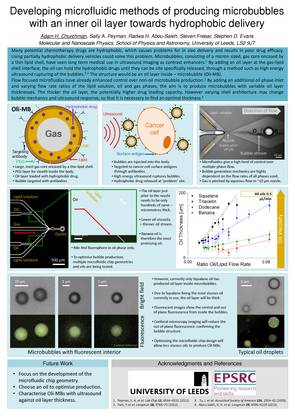
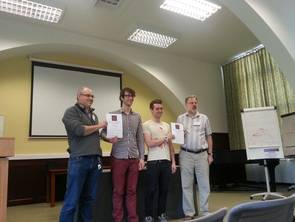
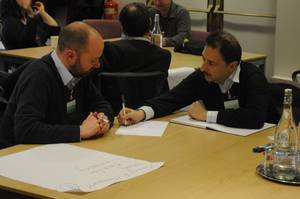
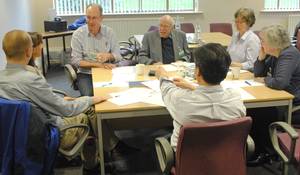
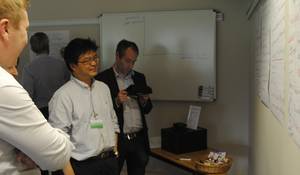
Physical Sciences and Oncology Away Day success
10th April
The School of Physics and Astronomy recently hosted a Physical Sciences and Oncology Away Day for the Faculty of MaPS. The delegate list included clinicians from the field of Oncology, it was an opportunity for both the Physical Scientists and Clinicians to get together to discuss the challenges. There were 40 delegates in total on the day.
Professor Steve Evans, Head of Group in MNP and Director of Research for the School, led the day and arranged for the following topics to be discussed:
- Steve Smye gave an overall introduction to the challenges that researchers in the field are currently facing and David Buckley gave a brief talk about Imaging.
- Understanding disease (Basic Sciences/Modelling), introduced by Professor Pam Jones
- Diagnostics (Imaging/Sensing) presented by Mr Greg Taylor from St James Hospital
- Treatment (Imaging/Delivery) by Professor Peter Selby
- Vivian Cosgrove also gave a brief introduction to Radiotherapy Physics Research
The day comprised of small group discussions and workshops, looking at refining the challenges, developing solutions and finally feeding back to the rest of the group.
The intention of the day was to develop new collaborations, we are pleased to say that a very positive outcome was established and we hope to be taking these new ideas forward very soon.
Thank you to everyone who was involved in the organisation of the day and for those delegates who took part in what we can confidently say was a very successful day.
Megan Hughes wins best presentation at recent PG Symposium
4th April 2014
Congratulations to Miss Megan Hughes on being awarded the best presentation at this years Postrgraduate Symposium, held on Tuesday 1st April 2014.
Megan is part of the Dougan group in Molecular & Nanoscale Physics and is currently focusing her research on physics proteins, which are biological molecules with very important functions in the cell. These molecules have unique 3D shapes and Megan is interested in the importance of the forces that hold this 3D shape together.
To see Megan's prize winning presentation, please click here
Victoria Mico wins best poster prize at recent PG Symposium
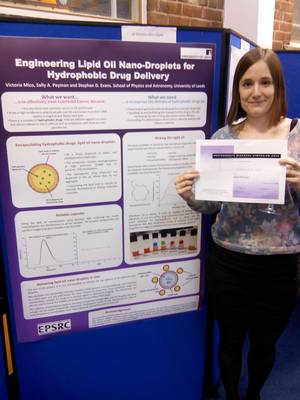 4th April 2014
4th April 2014
Congratulations to Miss Victoria Mico for winning the best poster prize at this years Annual Postgraduate Symposium.
The poster focused on 'Engineering lipid oil nano-droplets for hydrophobic drug delivery', and included input from Dr Sally Peyman and Professor Stephen Evans. To take a look at the winning poster, please click here
The PG Symposium is held every year at University of Leeds and is a great opportunity for PG in Physics and Astronomy to showcase their research in particular areas.
Registration Opens for this years Microbubble Symposium
1st April 2014
Registration for the Annual Microbubble Symposium opens today, to register, please visit our Microbubble webpage
For a full list of speakers and further details about the Symposium, please click here
This is the fourth year Leeds Microbubble Consortium have hosted the Symposium, for details about previous years, please click here
PhD position: New single molecule techniques for understanding protein-DNA interactions
28th March
DEADLINE: 1st MAY 2014
BACKGROUND
Protein-DNA interactions are central to many major cellular processes, including transcription, replication, and packaging of DNA into chromatin. However, we still know very little about how proteins interact physically with DNA. Without this basic knowledge we will be unable to understand many of the processes underpinning nucleic acid metabolism. New approaches are therefore required to probe directly how proteins bind to and manipulate DNA.
THE PROJECT
The project will exploit novel single molecule approaches to examine protein-DNA complexes with unprecedented molecular resolution. The ability to control, manipulate and interrogate single molecules will provide powerful insight into the function of these systems and, ultimately, will help us to understand the processes that underpin all aspects of nucleic acid metabolism. The project will make use of novel direct physical approaches to characterise the stability, flexibility and function of protein-DNA complexes (force clamp AFM) and will benefit from the unique collection of skills and experience of the research team.
The project is a collaboration between Dr Lorna Dougan in Physics at Leeds and Prof Peter McGlynn in Biology at York.
THE NETWORK
This project forms part of a new White Rose studentship network “New single molecule techniques for understanding the physics of living systems” and is made up of a team of collaborators from the Universities of Sheffield, Leeds and York. The goal of the network is to develop new physical approaches to answer biological questions and new ways for working collaboratively across the physics-life science interface to maximise the impact of these approaches.
If you are interested, please contact Dr Lorna Dougan - l.dougan@leeds.ac.uk
Registration for the Microbubble Symposium on April 1st
24th March
Registration will open for the Annual Microbubble Symposium on Tuesday 1st April.
This year we have another impressive line up of high profile speakers from the Microbubble field, including:
Valeria Garbin, Ian Miller, Jose Manuel Gordillo Arias de Saavedra, Abraham Lee, T.G.Leighton, Michiel Postema, Neil Thomson, Alexander Klibanov and Juergen Willmann
The Symposium will run over 2 days, from 1pm on Monday 14th July to Tuesday 15th July.
Full details of registration costs will be available on the Microbubble website from 1st April.
Leeds' Academic's speak at LCMB conference in India
7 March 2014
Professor Stephen Evans and Professor Richard Bushy recently attended the 'Light in Chemistry, Materials and Biology' in Kharagpur, India. Both were invited to speak at the conference and Richard was announced as the guest of honour.
The conference ran from 24th to 25th February 2014 at the Indian Institute of Technology in Kharagpur.
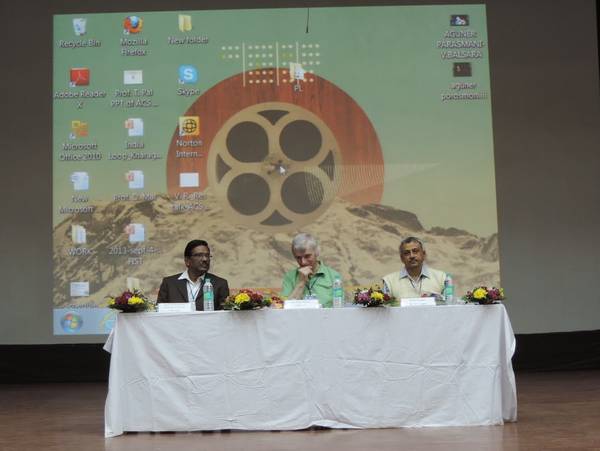
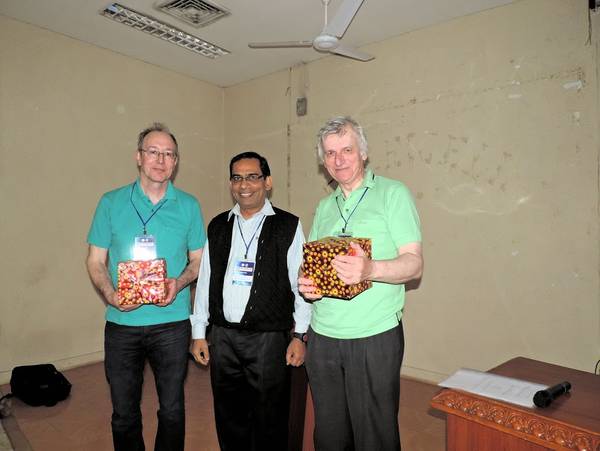
Speakers Announced for Forthcoming Microbubble Symposium
13 February 2014
We are pleased to confirm the following people will be speaking at this year's...
We are pleased to confirm the following people will be speaking at this year's Microbubble Symposium at Weetwood Hall, 14-15 July:
- Valeria Garbin - Imperial College London
- Jose Manuel Gordillo Arias de Saavedra - Sevilla University
- Alexander Klibanov - University of Virginia
- Abraham Lee - UC Irvine
- T.G.Leighton - University of Southampton
- Michiel Postema - University of Bergen
- Ronald Roy - University of Oxford
- Neil Thomson - University of Leeds
- Juergen Karl Willmann - Stanford University
Registration will open on 1st April, further details will be listed on our Microbubble page, here
Leeds Microbubble Group attend 19th European Symposium on Ultrasound Contrast Imaging
23-24th January 2014
Members of the Leeds Microbubble Group attended the 20th European Symposium on Ultrasound Contrast Imaging in Rotterdam.
Sally Peyman produced the following poster about Microbubbles as stable drug-loadable structures toward targeted, triggered drug delivery, which can be viewed here.
For more information please click here.
Leeds Microbubble Group feature in Soft Matter blog
Issue 5, 2014
'Self-assembly of actin scaffolds on lipid microbubbles.' Please use the links below to take a further look at the paper and also the front cover of the blog.
Congratulations to those involved: George R. Heath, Radwa H. Abou-Saleh, Sally A. Peyman, Benjamin R.G. Johnson, Simon D. Connell and Stephen D. Evans
Microbubble Symposium 2013
The Annual Leeds Microbubble Symposium was held in June 2013 this year. Guest speakers included a number of world leaders in Microbubble research. The list of speaker is as follows:
Mark Borden, Eleanor Stride, Mangala Srinivas ,Michael Versluis, James McLaughlan, Oliver Couture, Georg Schmitz, Georg Feichtinger, Lori Bridal, Alexander Kilbanov, Klazina Koiiman, Heleen Dewitte, Jeff Bamber, Sandra Meyer and Paul Sidhu.
More details about the Annual Symposium can be found here.
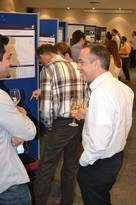
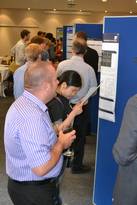
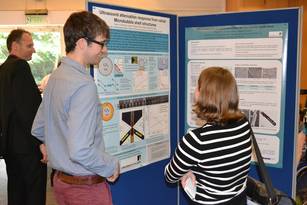
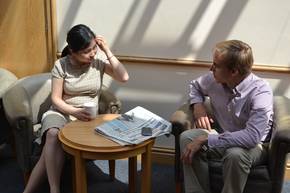
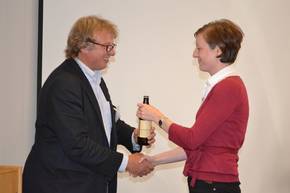
The HORIZON
14 July 2013
Epigem and University of Leeds unveil first Microbubble Instrument - The HORIZON - for more information, click here




























